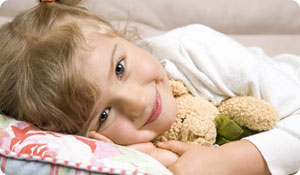
Encountering a sleepwalker can be a bit bizarre. Like the classic horror film, Night of the Living Dead where zombie-like figures walk around scaring ordinary folks, sleepwalkers appear awake but aren't. Their unusual behavior can be upsetting to parents and siblings but most incidences of sleep walking are benign and generally cease during adolescence.
If you're living with a sleepwalker, here's what you should know before your child takes his next nighttime stroll.
Sleepwalking, or somnambulism, is walking while asleep without being aware of the event. Although a sleepwalker's eyes are open they don't see what you see. They may think they are in different rooms of the house or in another place all together.
If you talk to a sleepwalker the conversation won't make sense but don't worry, your night owl will have no recollection of it. Sleepwalkers often do much more than walk. It's not unusual for them to engage in complicated behaviors such as opening doors and going outside, climbing out windows, or taking off clothes and urinating in inappropriate places.
Though sleepwalking can occur at any age, it happens most frequently in children between the ages of 4 and 8 and is more common in boys than girls. This sleep disorder is also thought to run in families—80 percent of children who sleep walk have a family member who has exhibited similar behavior.
The National Sleep Foundation estimates that the prevalence of the condition may be as high as 15 percent in the general population. Bedwetting, night terrors, and sleep apena (pauses in breathing during sleep) sometimes accompany sleepwalking. Illness, fever, or stress can also contribute as well.
Keeping Your Sleepwalker Safe
According to experts at Duke University, normal sleep is divided into two phases: rapid eye movement (REM) sleep and non-REM (NREM) sleep. NREM sleep makes up approximately 75 percent of sleep time and occurs mainly during the first third of the night. Sleep walking typically takes place within a couple of hours of the child falling asleep (REM sleep is recorded more in the early morning hours which is when dreams and nightmares arise.)
Get your sleepwalker back to bed without incident with these tips:
Don't wake your sleep walker. If you accidentally awaken him, he is likely to be confused or disoriented. Instead, gently guide him back to bed once the episode has run its course. While sleepwalking episodes can last up to 30 minutes, the majority are brief lasting just a few minutes.
Because sleepwalkers can be clumsy, take measures to prevent injury. Clear the floor of clutter or other obstacles such as electrical cords or furniture that may be hazardous if left in the path of a disoriented child. Lock windows and use a baby gate at the top of a staircase to help keep steps off limits.
Don't allow sleepwalkers to sleep in bunk beds.
Remove breakable, sharp, or otherwise dangerous objects from your child's room as sleep walking can be associated with combative behavior.
Minimize fluid consumption in the evening. A full bladder can contribute to the condition.
Be sure the child keeps a regular bedtime as sleep deprivation can trigger sleepwalking.
Treatment for sleepwalking is usually not necessary. Speak with your pediatrician if you are concerned about very regular episodes of sleepwalking; if it causes your child to be excessively sleepy during the day, or if your child does not outgrow it by the time she is a teenager.
Your doctor may recommend keeping a "sleep diary" to record the times when your child sleepwalks. This can help establish a pattern that will in turn enable a parent to intervene by waking the child 15 minutes before a sleepwalking episode is likely to occur. Known as scheduled awakening, this treatment may solve the problem.
In the meantime, try not to worry. Sleepwalking itself is not harmful and is not usually a sign that something is emotionally or psychologically wrong with a child.
Sources:
Duke University
www.dukehealth.org
Nemours Foundation
www.kidshealth.org
The Sleep Foundation
www.sleepfoundation.org





